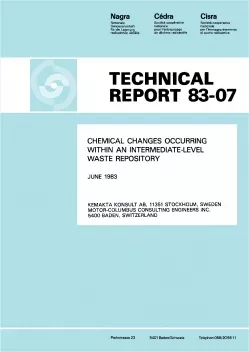
Technical Report NTB 83-07
Chemical changes occurring within an intermediate-level waste repository
The 80'000 m3 of waste intended for disposal in a Swiss inter mediate-level (type B) waste repository contain various materials which can undergo chemical changes. In this report such changes are identified, with special emphasis being given to processes which may be important for the safety assessment of the repository. The type of change which appears most important from this point-of-view is gas formation inside the repository. Three gas generating processes are described and, as far as possible, quantified and represented in terms of a most probable range. The
amounts produced are expressed in m3 gas at atmospheric pressure.
These processes are:
- Radiolytic decomposition of different materials, primarily decommissioning waste, which could generate approx. 10'000 m3 of hydrogen within 20 years.
- Microbial degradation which can generate 100'000 – 200'000 m3 of hydrogen and methane within 200 years. The carbon dioxide generated will be absorbed by concrete if this material is used as an immobilization agent and/or backfill medium.
- Corrosion, which is the most important gas generating reaction, can produce 200'000 – 1'400'000 m3 of hydrogen within 100 years. Enough water for corrosion to occur will be supplied by free water present in the waste and the backfill.
Although not treated in detail in this report, the transportation of gas from the repository to the biosphere could take place as a result of gas flow through the fissures in the host rock surrounding the repository. The permeability of the host rock is expected to have the major influence on gas transportation capabilities.
Chemical changes within the waste will have an influence on the properties of the barriers used. Changes such as radiolytic decomposition of ion exchange resins, the swelling of such resins and the interaction between concrete and bentonite, are considered.
